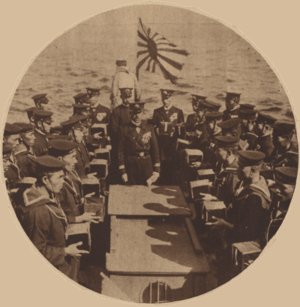Japanese destroyer Sakaki (1915)
Sakaki (榊, "Sakaki Tree") was a Japanese destroyer of the Kaba-class, built in Japan, that served in the last part of World War I, and throughout World War II, as part of the Imperial Japanese Navy. While operating near Malta Sakaki was hit and damaged by Austro-Hungarian Navy U-boat U-27.
 Japanese sailors bring ashore boxes containing the cremated remains of the first Japanese victims of the war, the crew of the Japanese destroyer Sakaki, sunk on 11 June 1917 Austro-Hungarian Navy U-boat U-27 hit Sakaki off Crete killing 68 of her 92 crewmen.[1] | |
| History | |
|---|---|
| Name: | Sakaki |
| Builder: | |
| Laid down: | 1 December 1914 |
| Launched: | 31 March 1915 |
| Fate: | Retired 1 April 1932 |
| General characteristics | |
| Type: | Destroyer |
| Displacement: |
|
| Length: |
|
| Beam: | 7.3 m (24 ft) |
| Draught: | 2.3 m (7.5 ft) |
| Propulsion: | 3-shaft reciprocating, 2 heavy oil-fired + 2 oil/coal-fired boilers 9,500 ihp (7,100 kW) |
| Speed: | 30 knots (56 km/h) |
| Range: | 1,200 nautical miles (2,200 km) at 12 knots (22 km/h) |
| Complement: | 94 |
| Armament: |
|
Background
At the outbreak of World War I, the Imperial Japanese Navy had a total of two modern destroyers capable of overseas deployment: the Sakura class Sakura and Tachibana. It was clear that this force would not enable Japan to fulfill its obligations under the Anglo-Japanese Alliance, so the Japanese government pushed through an Emergency Naval Expansion Budget in fiscal 1914 to allow for the construction of ten new destroyers. As speed was of the essence, the orders were given to both government and civilian shipyards (as was the case with the construction of the Russo-Japanese War vintage Kamikaze-class). [2]
Twelve more vessels were built by the same shipyards in Japan per an order from the French Navy, where they were designated the Tribal class (or Arabe class) [3] named Algérien, Annamite, Arabe, Bambara, Hova, Kabyle, Marocain, Sakalave, Sénégalais, Somali, Tonkinois, and Touareg. The Arabe class were the most advanced destroyers in the French inventory in World War I.[4]
Design
The ten Kaba-class vessels were built simultaneously at eight different shipyards around Japan. As there was no time to design a new vessel, plans for the previous Sakura-class destroyers were distributed to each shipyard, with the instructions that the power plant was to be a conventional coal-fired triple expansion steam engine, and not a steam turbine.
Armament was the same as that of the Sakura class, with one QF 4.7 inch Gun Mk I – IV, mounted on the deck forward of the bridge, and four 3 inch 12 pounder guns, mounted one on either side and two towards the stern of the ship, with two torpedo launchers.
Operational history
Given the speed of construction and the fact that eight different shipyards were used, it is a tribute to the Japanese shipbuilders that all ten sister ships of the Sakaki were uniform in appearance and capabilities, and performed reliably in their overseas deployment to the Indian Ocean and the Mediterranean Sea in combat operations in World War I. [5] This deployment began with Rear Admiral Kozo Sato arrived in Malta in mid-April 1917, with the cruiser Akashi as his flagship and eight Kaba-class destroyers.[6] [7] The Japanese fleet was nominally independent, but carried out operations under the direction of the Royal Navy command on Malta, primarily in escort operations for transport and troopship convoys and in anti-submarine warfare operations.[7]
Sakaki was damaged by the Austro-Hungarian Navy U-boat U-27 on 11 June 1917 off of Crete with the loss of 68[A 1] of her 92 crewmen, including her skipper.[8] [9] [10] She was salvaged and repaired.[11][12] The ashes of the dead Japanese sailors were returned to Japan by the Imperial Japanese Navy.[1] The Japanese Naval Memorial at Kalkara Naval Cemetery in Malta commemorates the casualties of the 1917 attack.[13]
Bibliography
Notes
- Authors Evan & Peattie say that 59 were KIA[8]
- New-York Tribune, December 2, 1917, p. 4.
- Howarth 1983.
- "Arabe French destroyer class". Retrieved 21 December 2016.
- Tucker & Mary 2005, p. 165.
- Jentschura, Jung & Mickel 1977.
- "Japanese Navy, IJN, World War 1". Retrieved 21 December 2016.
- Halpern 1995, p. 393.
- Evans & Peattie 2015, p. 169.
- Tucker & Mary 2005, p. 1069.
- Saxon 2000, p. 62.
- "Japanese Destroyers". Retrieved 21 December 2016.
- "Japanese Navy, IJN, World War 1". Retrieved 21 December 2016.
- "Imtarfa Military Cemetery". Commonwealth War Graves Commission.
References
- Evans, David C.; Peattie, Mark (2015). Kaigun: Strategy, Tactics, and Technology in the Imperial Japanese Navy, 1887–1941. Naval Institute Press. ISBN 978-1-61251-425-3.CS1 maint: ref=harv (link)
- Halpern, Paul G. (1995). A Naval History of World War I. UCL Press. ISBN 978-1-85728-498-0.CS1 maint: ref=harv (link)
- Howarth, Stephen (1983). The Fighting Ships of the Rising Sun: The Drama of the Imperial Japanese Navy, 1895–1945. Atheneum. ISBN 978-0-689-11402-1.CS1 maint: ref=harv (link)
- Jentschura, Hansgeorg; Jung, Dieter; Mickel, Peter (1977). Warships of the Imperial Japanese Navy, 1869–1945. Naval Institute Press. ISBN 978-0-87021-893-4.CS1 maint: ref=harv (link)
- "Our Allies in their Common Cause". New-York Tribune. New York. 2 December 1917. pp. 1–10. ISSN 1941-0646. OCLC 9405688. Retrieved 8 December 2019.
- Saxon, Timothy D. (Winter 2000). "Anglo-Japanese Naval Cooperation, 1914–1918". Naval War College Review. United States Naval War College. 53 (1): 62–92. ISSN 0028-1484. LCCN 75617787. OCLC 01779130. Retrieved 7 December 2019.CS1 maint: ref=harv (link)
- Tucker, Spencer C; Mary, Priscilla (2005). World War I: Encyclopedia, Volume 1. ABC-CLIO. ISBN 978-1-85109-420-2.CS1 maint: ref=harv (link)
Further reading
- Cocker, Maurice (1983). Destroyers of the Royal Navy, 1893–1981. Ian Allan. ISBN 978-0-7110-1075-8.